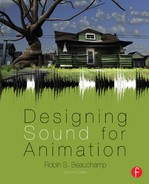CONTENTS
Chapter 1Foundations of Audio for Image
Diegetic and Non-Diegetic Sound
Drawing the Audience into the Narrative
Establishing or Clarifying Point of View
Contrasting Reality and Subjectivity
Promoting Character Development
Theoretical Concepts Specific to Dialogue
Theoretical Concepts Specific to Score
Theoretical Concepts Specific to SFX
Time-Lapse and Flashback Sequences
Title, Montage, and End Credit Sequences
Workflow for Production Libraries
Workflow for Copy-Protected Music
Synchronization, Master, and Videogram License
Historical Trends in Animation Scoring
Temp Tracks and Spotting Sessions
Developing an Original SFX Library
Suggestions for Field Recording
Area-Specific Frequency Response
Recording with Preparatory Cues
Developing a Soundtrack Budget
Production Tasks for the Sound and Music Departments
Postproduction Tasks for the Sound and Music Departments
Preparing Tracks for Delivery to the Mix
Creating the Stems and Printmaster
The Direct/Ambient Perspective
The “Inside the Band” Perspective
